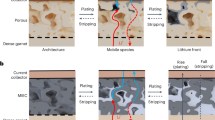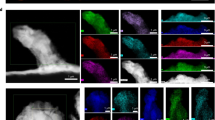Abstract
All-solid-state lithium (Li) metal and lithium-ion batteries (ASSLBs) with inorganic solid-state electrolytes offer improved safety for electric vehicles and other applications. However, current inorganic ASSLB manufacturing technology suffers from high cost, excessive amounts of solid-state electrolyte and conductive additives, and low attainable volumetric energy density. Such a fabrication method involves separate fabrications of sintered ceramic solid-state electrolyte membranes and ASSLB electrodes, which are then carefully stacked and sintered together in a precisely controlled environment. Here we report a disruptive manufacturing technology that offers reduced manufacturing costs and improved volumetric energy density in all solid cells. Our approach mimics the low-cost fabrication of commercial Li-ion cells with liquid electrolytes, except that we utilize solid-state electrolytes with low melting points that are infiltrated into dense, thermally stable electrodes at moderately elevated temperatures (~300 °C or below) in a liquid state, and which then solidify during cooling. Nearly the same commercial equipment could be used for electrode and cell manufacturing, which substantially reduces a barrier for industry adoption. This energy-efficient method was used to fabricate inorganic ASSLBs with LiNi0.33Mn0.33Co0.33O2 cathodes and both Li4Ti5O12 and graphite anodes. The promising performance characteristics of such cells open new opportunities for the accelerated adoption of ASSLBs for safer electric transportation.
This is a preview of subscription content, access via your institution
Access options
Access Nature and 54 other Nature Portfolio journals
Get Nature+, our best-value online-access subscription
$29.99 / 30 days
cancel any time
Subscribe to this journal
Receive 12 print issues and online access
$259.00 per year
only $21.58 per issue
Buy this article
- Purchase on Springer Link
- Instant access to full article PDF
Prices may be subject to local taxes which are calculated during checkout





Similar content being viewed by others
Data availability
The data used in this study are available from the authors upon reasonable request.
References
Manthiram, A., Yu, X. & Wang, S. Lithium battery chemistries enabled by solid-state electrolytes. Nat. Rev. Mater. 2, 16103 (2017).
Xu, K. Electrolytes and interphases in Li-ion batteries and beyond. Chem. Rev. 114, 11503–11618 (2014).
Kato, Y. et al. High-power all-solid-state batteries using sulfide superionic conductors. Nat. Energy 1, 16030 (2016).
Huang, Q. et al. Cycle stability of conversion-type iron fluoride lithium battery cathode at elevated temperatures in polymer electrolyte composites. Nat. Mater. 18, 1343–1349 (2019).
Wan, J. Y. et al. Ultrathin, flexible, solid polymer composite electrolyte enabled with aligned nanoporous host for lithium batteries. Nat. Nanotechnol. 14, 705–711 (2019).
Han, F. D. et al. High electronic conductivity as the origin of lithium dendrite formation within solid electrolytes. Nat. Energy 4, 187–196 (2019).
Han, X. et al. Negating interfacial impedance in garnet-based solid-state Li metal batteries. Nat. Mater. 16, 572–579 (2017).
Janek, J. & Zeier, W. G. A solid future for battery development. Nat. Energy 1, 16141 (2016).
Zhang, J. et al. All-solid-state batteries with slurry coated LiNi0.8Co0.1Mn0.1O2 composite cathode and Li6PS5Cl electrolyte: effect of binder content. J. Power Sources 391, 73–79 (2018).
Nykvist, B. & Nilsson, M. Rapidly falling costs of battery packs for electric vehicles. Nat. Clim. Change 5, 329–332 (2015).
Auvergniot, J. et al. Interface stability of argyrodite Li6PS5Cl toward LiCoO2, LiNi1/3Co1/3Mn1/3O2, and LiMn2O4 in bulk all-solid-state batteries. Chem. Mater. 29, 3883–3890 (2017).
Takada, K. et al. Solid-state lithium battery with graphite anode. Solid State Ion. 158, 269–274 (2003).
Yersak, T. A., Salvador, J. R., Pieczonka, N. P. W. & Cai, M. Dense, melt cast sulfide glass electrolyte separators for Li metal batteries. J. Electrochem. Soc. 166, A1535–A1542 (2019).
Tippens, J. et al. Visualizing chemomechanical degradation of a solid-state battery electrolyte. ACS Energy Lett. 4, 1475–1483 (2019).
McCloskey, B. D. Attainable gravimetric and volumetric energy density of Li–S and Li ion battery cells with solid separator-protected Li metal anodes. J. Phys. Chem. Lett. 6, 4581–4588 (2015).
Trevey, J. E., Jung, Y. S. & Lee, S.-H. High lithium ion conducting Li2S–GeS2–P2S5 glass–ceramic solid electrolyte with sulfur additive for all solid-state lithium secondary batteries. Electrochim. Acta 56, 4243–4247 (2011).
Zhang, Q. et al. Sulfide-based solid-state electrolytes: synthesis, stability, and potential for all-solid-state batteries. Adv. Mater. 31, 1901131 (2019).
Kim, D. H. et al. Infiltration of solution-processable solid electrolytes into conventional Li-ion-battery electrodes for all-solid-state Li-ion batteries. Nano Lett. 17, 3013–3020 (2017).
Hitz, G. T. et al. High-rate lithium cycling in a scalable trilayer Li-garnet-electrolyte architecture. Mater. Today 22, 50–57 (2019).
Song, A.-Y. et al. Protons enhance conductivities in lithium halide hydroxide/lithium oxyhalide solid electrolytes by forming rotating hydroxy groups. Adv. Energy Mater. 8, 1700971 (2018).
Schwering, G., Honnerscheid, A., van Wullen, L. & Jansen, M. High lithium ionic conductivity in the lithium halide hydrates Li3-n(OHn)Cl (0.83 ≤ n ≤ 2) and Li3-n(OHn)Br (1 ≤ n ≤ 2) at ambienttemperatures. ChemPhysChem 4, 343–348 (2003).
Dawson, J. A. et al. Elucidating lithium-ion and proton dynamics in anti-perovskite solid electrolytes. Energy Environ. Sci. 11, 2993–3002 (2018).
Kerman, K., Luntz, A., Viswanathan, V., Chiang, Y. M. & Chen, Z. B. Review—practical challenges hindering the development of solid state Li ion batteries. J. Electrochem Soc. 164, A1731–A1744 (2017).
Albertus, P., Babinec, S., Litzelman, S. & Newman, A. Status and challenges in enabling the lithium metal electrode for high-energy and low-cost rechargeable batteries. Nat. Energy 3, 16–21 (2018).
Song, A. Y. et al. Understanding Li-ion dynamics in lithium hydroxychloride (Li2OHCl) solid state electrolyte via addressing the role of protons. Adv. Energy Mater. https://doi.org/10.1002/aenm.201903480 (2020).
Hood, Z. D., Wang, H., Pandian, A. S., Keum, J. K. & Liang, C. D. Li2OHCl crystalline electrolyte for stable metallic lithium anodes. J. Am. Chem. Soc. 138, 1768–1771 (2016).
Li, Y. T. et al. Fluorine-doped antiperovskite electrolyte for all-solid-state lithium-ion batteries. Angew. Chem. Int. Ed. 55, 9965–9968 (2016).
Tomita, Y., Matsushita, H., Kobayashi, K., Maeda, Y. & Yamada, K. Substitution effect of ionic conductivity in lithium ion conductor, Li3InBr6–xClx. Solid State Ion. 179, 867–870 (2008).
Li, X. N. et al. Air-stable Li3InCl6 electrolyte with high voltage compatibility for all-solid-state batteries. Energ. Environ. Sci. 12, 2665–2671 (2019).
Yamada, K., Kumano, K. & Okuda, T. Lithium superionic conductors Li3InBr6 and LiInBr4 studied by 7Li, 115In NMR. Solid State Ion. 177, 1691–1695 (2006).
Li, X. N. et al. Water-mediated synthesis of a superionic halide solid electrolyte. Angew. Chem. Int. Ed. 58, 16427–16432 (2019).
Asano, T. et al. Solid halide electrolytes with high lithium-ion conductivity for application in 4 V class bulk-type all-solid-state batteries. Adv. Mater. https://doi.org/10.1002/adma.201803075 (2018).
Maekawa, H. et al. Halide-stabilized LiBH4, a room-temperature lithium fast-ion conductor. J. Am. Chem. Soc. 131, 894–895 (2009).
Unemoto, A. et al. Pseudo-binary electrolyte, LiBH4-LiCl, for bulk-type all-solid-state lithium-sulfur battery. Nanotechnology https://doi.org/10.1088/0957-4484/26/25/254001 (2015).
Unemoto, A. et al. Stable interface formation between TiS2 and LiBH4 in bulk-type all-solid-state lithium batteries. Chem. Mater. 27, 5407–5416 (2015).
Lu, F. Q. et al. A high-performance Li–B–H electrolyte for all-solid-state Li batteries. Adv. Funct. Mater. https://doi.org/10.1002/adfm.201809219 (2019).
Ley, M. B. et al. LiCe(BH4)3Cl, a new lithium-ion conductor and hydrogen storage material with isolated tetranuclear anionic clusters. Chem. Mater. 24, 1654–1663 (2012).
Duchêne, L., Remhof, A., Hagemann, H. & Battaglia, C. Status and prospects of hydroborate electrolytes for all-solid-state batteries. Energy Storage Mater. 25, 782–794 (2020).
Sun, Y. K., Cho, S. W., Myung, S. T., Amine, K. & Prakash, J. Effect of AlF3 coating amount on high voltage cycling performance of LiCoO2. Electrochim. Acta 53, 1013–1019 (2007).
Kim, J. S. et al. The electrochemical stability of spinel electrodes coated with ZrO2, Al2O3, and SiO2 from colloidal suspensions. J. Electrochem Soc. 151, A1755–A1761 (2004).
Hall, D. S., Gauthier, R., Eldesoky, A., Murray, V. S. & Dahn, J. R. New chemical insights into the beneficial role of Al2O3 cathode coatings in lithium-ion cells. ACS Appl. Mater. Interfaces 11, 14095–14100 (2019).
Dupre, N., Martin, J. F., Guyomard, D., Yamada, A. & Kanno, R. Detection of surface layers using 7Li MAS NMR. J. Mater. Chem. 18, 4266–4273 (2008).
Liu, B. Y. et al. Garnet solid electrolyte protected Li-metal batteries. ACS Appl. Mater. Interfaces 9, 18809–18815 (2017).
Oh, D. Y. et al. Excellent compatibility of solvate ionic liquids with sulfide solid electrolytes: toward favorable ionic contacts in bulk-type all-solid-state lithium-ion batteries. Adv. Energy Mater. https://doi.org/10.1002/aenm.201500865 (2015).
Zhang, Z. et al. A self-forming composite electrolyte for solid-state sodium battery with ultralong cycle life. Adv. Energy Mater. 7, 1601196 (2017).
Strauss, F. et al. Rational design of quasi zero-strain NCM cathode materials for minimizing volume change effects in all-solid-state batteries. ACS Mater. Lett. https://doi.org/10.1021/acsmaterialslett.9b00441 (2019).
Sugumar, M. K., Yamamoto, T., Motoyama, M. & Iriyama, Y. Room temperature synthesis of anti-perovskite structured Li2OHBr. Solid State Ion. 349, 115298 (2020).
Lin, S.-C. & Burks, S. J. Compatible polyvinylidene fluoride blends with polymers containing imide moieties. US patent 5,959,022 (1999).
Acknowledgements
This work was mostly supported by Sila Nanotechnologies. We thank the Materials Characterization Center (MCF) at Georgia Tech.
Author information
Authors and Affiliations
Contributions
Y.X. performed battery assembly and electrochemical tests; Y.X., K.T., A.N., A.S., X.R., A.M., A.J., S.H. and H.L. performed materials synthesis and characterization; Y.X., K.T., A.S. and G.Y. interpreted the experimental results and wrote the paper. G.Y. conceived the idea.
Corresponding author
Ethics declarations
Competing interests
G.Y. is a stockholder of Sila Nanotechnologies.
Additional information
Peer review information Nature Materials thanks the anonymous reviewers for their contribution to the peer review of this work.
Publisher’s note Springer Nature remains neutral with regard to jurisdictional claims in published maps and institutional affiliations.
Supplementary information
Supplementary Information
Supplementary Figs. 1–13 and caption of Video 1.
Supplementary Video 1
Melt-infiltration process of SSE into an NCM111 electrode.
Rights and permissions
About this article
Cite this article
Xiao, Y., Turcheniuk, K., Narla, A. et al. Electrolyte melt infiltration for scalable manufacturing of inorganic all-solid-state lithium-ion batteries. Nat. Mater. 20, 984–990 (2021). https://doi.org/10.1038/s41563-021-00943-2
Received:
Accepted:
Published:
Issue Date:
DOI: https://doi.org/10.1038/s41563-021-00943-2
This article is cited by
-
An in-situ polymerized interphase engineering for high-voltage all-solid-state lithium-metal batteries
Nano Research (2024)
-
Inorganic glass electrolytes with polymer-like viscoelasticity
Nature Energy (2023)
-
Boosting lithium ion conductivity of antiperovskite solid electrolyte by potassium ions substitution for cation clusters
Nature Communications (2023)
-
A room-temperature ionic liquid-based superionic conductive polymer electrolyte with high thermal stability for long-cycle-life lithium batteries
Colloid and Polymer Science (2022)
-
Liquid-phase sintering enabling mixed ionic-electronic interphases and free-standing composite cathode architecture toward high energy solid-state battery
Nano Research (2022)



